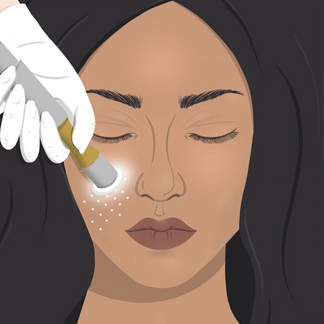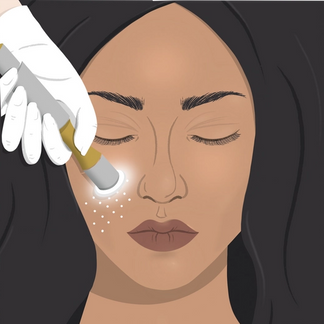Laser Skin Treatments Overview
Laser treatments are commonly associated with hair removal, but the use of light, in various forms, has been used since the 1960s for a myriad of skin issues such as sun-damage, pigmentation, lines and wrinkles, tattoo removal and stretch mark reduction.
In the last decade, there have been significant advances in the use of lasers in the world of aesthetics. Due to the adjustable nature of the laser machines, treatments can be used on most skin types, colours and areas, including around the eyes, lips and eyelids.
What is laser and how does it work?
Laser is a very high energy beam of laser light. Different lasers can be set to different wavelengths of light, so their strength and depth of penetration can be varied.
The laser beam heats up water in skin cells, at a specific depth, causing them either to vaporise or injure them in a controlled way. This intentional, controlled cell damage leads to new, thicker layers of skin with increased levels of elastin and collagen being made. Resulting in younger, more even, healthier looking skin with fewer lines, wrinkles and pigmentation.
What are the different types of laser?
There are various categories of laser:
Ablative lasers – these completely remove the epidermis and some of the dermis by vapourising the skin cells. This means that the skin is effectively removed to a specific depth causing a resurfacing effect. New skin cells are made to repair the intentional injury sustained by the skin. This results in thicker, smoother skin. Ablative laser treatments produce dramatic results but this comes with significant discomfort and downtime. Following an ablative laser treatment, skin will be red, weeping, sore and itchy. Think of the worse sunburn you've ever had, and then some. The adage "No pain, no gain" really applied.
Non-ablative lasers – these cause controlled tissue injury in the dermis by heating it to a specific temperature and depth, leaving the epidermis intact. Non-ablative lasers lead to extensive dermal remodelling, where collagen is tightened, and fibroblasts are stimulated to produce additional collagen and elastin. Results are more moderate than ablative lasers, but there is no downtime, no peeling and only short-lived redness. So, the results are still great, but you'd likely need more treatments to get anywhere near the results of one ablative laser treatment.
There's another layer of complication with lasers. Both ablative and non-ablative lasers can be either fractional or non-fractional
Non-fractional lasers treat the whole area exposed to the laser. Non-fractional laser treatments are more aggressive than fractional laser treatments.
Fractional lasers treat a portion of the area exposed to the laser (i.e. they treat a fraction of the skin). This leaves channels of laser treated tissue (called Microscopic Thermal Zones - MTZs) surrounded by healthy, untreated tissue. This means that recovery times and side effects are much reduced compared to non-fractional lasers.
Can anyone have laser?
There have been real advances in laser technology in recent years, meaning that there are now lasers suitable for all skin tones. However, NEVER allow just anyone near your skin with a laser as the potential risks are significant. Ensure that your practitioner has knoweldge and experience in treating your particular skin issue, especially if you have brown or black skin.
How can they tell laser is OK for your skin?
Prior to any laser treatments, you should be asked to complete a Fitzpatrick Test. This will enable your practitioner to determine the correct wavelength for your hair colour, skin colour and type.
A patch test will also be carried out on each area you are going to have treated at least 24 hours prior to your treatment taking place. This will help determine whether you have any unwanted reaction to the laser treatment.
How much is it going to cost?
The cost of laser varies depending on the type of laser and the area to be treated.
For non-ablative laser treatments, expect to pay anywhere from £200 to £600 for a single treatment and £2000 to £3000 for a full face.
Ablative treatments are more costly. A small area (e.g. around eyes) can cost upwards of £1000, with a full-face costing £4000 or more.
These treatment guides have been verified and edited by Dr Sophie Shotter.

